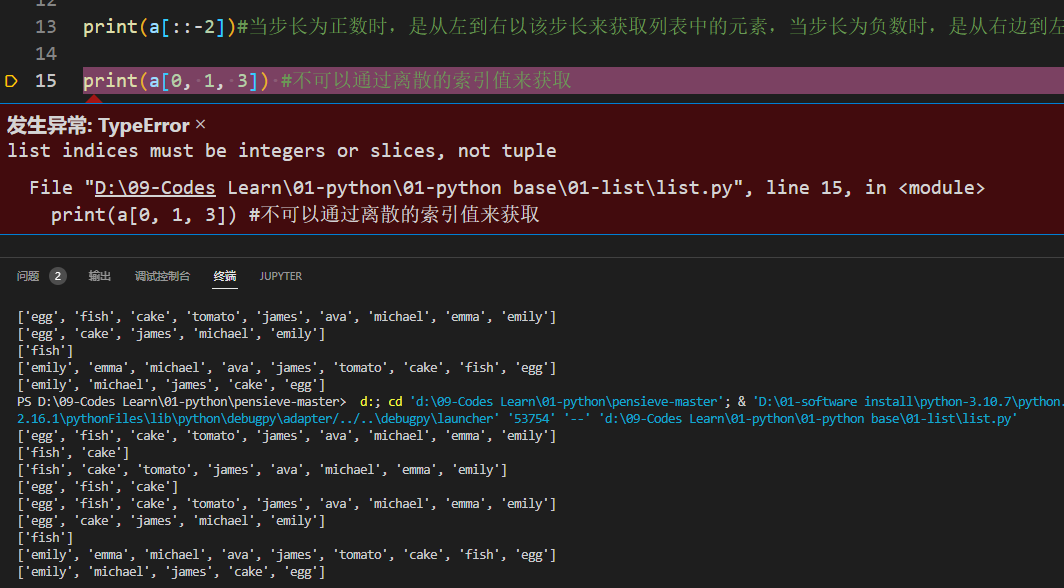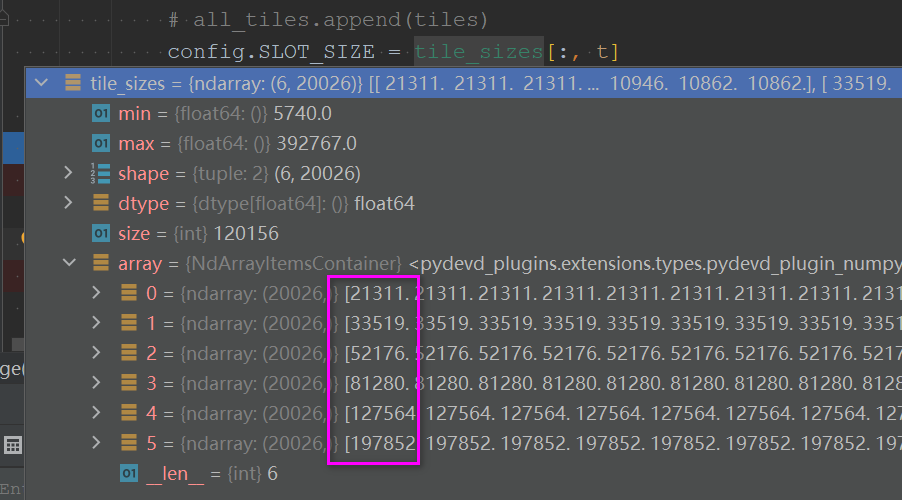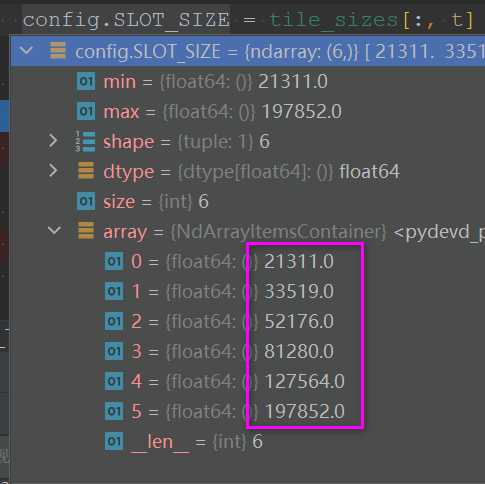1.[::]
适用于Python中的list(也就是数组),也适用于numpy科学结构(array等)。
使用方法[start: end : step ],也就是[ 起始下标 : 终止下标 : 间隔距离 ]
切片范围是: start <= x < end,注意:一个小于等于,一个小于。
- 例1
a=['egg', 'fish', 'cake', 'tomato', 'james', 'ava', 'michael', 'emma', 'emily']
print(a[1:3]) #按下标0开始,不包括最右边的3
print(a[1:]) #1以及之后的全部
print(a[:3]) #3之前的但不包括3
print(a[:]) #所有
print(a[::2])#[start:end:step]start和end为空的时候,默认是全选,step为空时默认是1,这个表示的是从索引为0开始,以步长为2来选择元素
print(a[1:3:2])#以索引为1开始,索引3结束,步长为2来选择元素
print(a[::-1])#当step为-1时,将列表进行了逆序排序
print(a[::-2])#当步长为正数时,是从左到右以该步长来获取列表中的元素,当步长为负数时,是从右边到左以该步长的绝对值来获取的元素
print(a[0, 1, 3]) #不可以通过离散的索引值来获取,type error
输出
['egg', 'fish', 'cake', 'tomato', 'james', 'ava', 'michael', 'emma', 'emily']
['fish', 'cake']
['fish', 'cake', 'tomato', 'james', 'ava', 'michael', 'emma', 'emily']
['egg', 'fish', 'cake']
['egg', 'fish', 'cake', 'tomato', 'james', 'ava', 'michael', 'emma', 'emily']
['egg', 'cake', 'james', 'michael', 'emily']
['fish']
['emily', 'emma', 'michael', 'ava', 'james', 'tomato', 'cake', 'fish', 'egg']
['emily', 'michael', 'james', 'cake', 'egg']

- 例2
a = [[1,2,3,4],[2,3,4,5],[5,6,7,8]]
# a是Python的一个列表(数据结构上叫做数组)
print(a)
# 例子1
print(a[:2])
# 例子2
print(a[1][:3])
输出
[[1, 2, 3, 4], [2, 3, 4, 5], [5, 6, 7, 8]]
[[1, 2, 3, 4], [2, 3, 4, 5]]
[2, 3, 4]
2.[ :,j]
这也是切片操作,不同的是:保留第一个维度所有元素,第二维度元素保留到j;
只适用numpy的科学数据结构
- 例3
import numpy as np
# b是一个numpy科学数据结构,格式是array
b = np.array([[1,2,3,4],[2,3,4,5],[5,6,7,8]])
print(b)
# 例子1
print(b[:,2])
# 例子2
print(b[:,3])
# 非numpy数据结构的例子不能使用 [:,j]
x=list([[1, 2, 3, 4], [2, 3, 4, 5], [5, 6, 7, 8]])
print(x)
# 例子3
print(x[:, :2])
---------------------------------------------------------------------------
TypeError Traceback (most recent call last)
<ipython-input-5-4b22ebda2101> in <module>()
----> 1 x[:,:2]
TypeError: list indices must be integers or slices, not tuple
输出
[[1 2 3 4]
[2 3 4 5]
[5 6 7 8]]
[3 4 7]
[4 5 8]
[[1, 2, 3, 4], [2, 3, 4, 5], [5, 6, 7, 8]]
- 例4
labels = []
# prepare the network trace for each user in this round
net_traces = []
for trace_file in trace_files[k]:
user_trace = []
with open(trace_file) as f:
lines = f.readlines()
duration = 0
t = 0
# random.shuffle(lines)
for line in lines:
tokens = line.split(' ')
temp_duration = int(tokens[5])
throughput = tokens[4]
throughput_MB = float(int(throughput) / 1e6)
while (t + 1) * config.TIME_INTERVAL - duration < temp_duration:
# add some variance
# user_trace.append(max(throughput_MB + np.random.normal(0,throughput_MB/10),1.356))
# without variance
user_trace.append(throughput_MB)
t += 1
duration = t * config.TIME_INTERVAL
if t >= config.T:
break
net_traces.append(user_trace[:int(config.T)])
net_traces = np.array(net_traces)
.................
.................
for t in range(int(config.T)):
config.SLOT_SIZE = tile_sizes[:, t]
输出调试
tile_sizes

config.SLOT_SIZE

3. [::]操作高阶用法
- 例5
# 关于array的科学数据
In [5]: x = np.random.randint(1,10,(3,6))
In [6]: x
Out[6]:
array([[9, 3, 2, 3, 8, 4],
[3, 5, 6, 8, 4, 3],
[8, 5, 5, 2, 5, 8]])
In [7]: x[:, 0:2:2]
Out[7]:
array([[9],
[3],
[8]])
In [8]: x[:, :2:2]
Out[8]:
array([[9],
[3],
[8]])
In [9]: x[:, ::2]
Out[9]:
array([[9, 2, 8],
[3, 6, 4],
[8, 5, 5]])
# 关于List
In [10]: d =[[3, 4, 8, 8, 8, 9],
...: [8, 9, 6, 3, 4, 9],
...: [6, 7, 6, 6, 7, 1]]
...:
# 在元素层面,切片是可以用的
In [11]: d
Out[11]: [[3, 4, 8, 8, 8, 9], [8, 9, 6, 3, 4, 9], [6, 7, 6, 6, 7, 1]]
In [12]: d[::2]
Out[12]: [[3, 4, 8, 8, 8, 9], [6, 7, 6, 6, 7, 1]]
In [13]: d[:2:2]
Out[13]: [[3, 4, 8, 8, 8, 9]]
In [14]: d[0:2:2]
Out[14]: [[3, 4, 8, 8, 8, 9]]
# 下面不可以用了,因为逗号就代表你认为元素还可以切分,这是和定义一冲突的。
In [15]: d[1,::2]
---------------------------------------------------------------------------
TypeError Traceback (most recent call last)
<ipython-input-15-32535642f99b> in <module>()
----> 1 d[1,::2]
TypeError: list indices must be integers or slices, not tuple
- 注意
1)定义一:在list里面,只存在元素,不存在元素中的元素;list里元素就是最小的成分,不可以再切片。
2)定义二:在array中(numpy的数据都可以)最后一个维度的数据才可以叫做元素,同样元素不可切分。
结合例子解释定义一:就算是二维、三维的list,元素就是axis=0的数据,例如数据x=[[1,2,3,4],[2,3,4,5],[5,6,7,8]],元素就是[1,2,3,4]或者[2,3,4,5]或者[5,6,7,8],而不是更里面的数字1等等;在二维列表中写下x[:],但是不可以写x[:,:],根据定义一,第二种x[:,:]切片操作是不合法的。





















 1973
1973











 被折叠的 条评论
为什么被折叠?
被折叠的 条评论
为什么被折叠?








